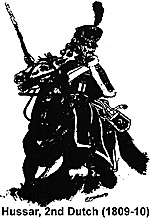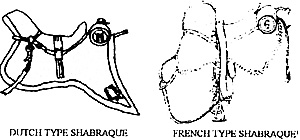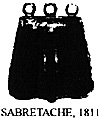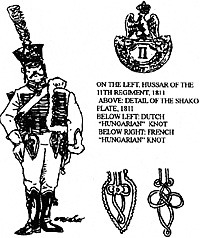 Partly because of specific uniform features, some of them quite innovative, the 11th Hussars (ex-2nd Dutch Hussars) was a somewhat different Hussar regiment.
Partly because of specific uniform features, some of them quite innovative, the 11th Hussars (ex-2nd Dutch Hussars) was a somewhat different Hussar regiment.
In 1810, Napoleon simply annexed Holland to the French Empire and, consequently, the Dutch army was incorporated into the French army. The 2nd Dutch Hussars regiment was in garrison in the French city of Arras (in the north of France) when the Imperial decree of August 18, 1810, incorporating the regiment in the French army, was promulgated. The regiment became the 11th Hussars and was to be reorganized as a French regiment. General de brigade Girard was given that task by General de Division Olivier. The reorganization was completed on September 25, 1810, and, at that date, General Girard reviewed the regiment, still commanded by Colonel Collaert and still garrisoned in Arras. The regiment had an effective of 37 officers and 712 NCOs and troopers, distributed among its 4 "war" squadrons, with a total of 8 "war" companies, plus a 9th depot company. [1] The elite company, as shown in the inspection report, had 720 Hussars wearing busbies. In addition, we find in the regiment some 16 sappers equipped with an ax kept in a buff leather pouch.
In 1811, the 11th Hussars received a reinforcement of 396 Hussars from the 1st Dutch Hussars to conform with the decree ordering the raising of a fifth "war" squadron in all the Light Cavalry regiments. This brought up the effective to 42 officers and 1108 NCOs and troopers. We find the 11th Hussars in June 1812 part of the Grande Armée ready to invade Russia with an effective of 36 officers, 1029 NCOs and troopers (and 1138 horses) in 4 squadrons. (Note the shortage of officers since the theoretical number of officers in a Hussars regiment of 4 squadrons was 43 officers.)
Uniform
The uniform of the 2nd Dutch Hussars is shown in the drawing after a gouache kept at the Musée Royal de l'Armée et d'Histoire, (Royal Museum of the Army and History) at Brussels, Belgium. The uniform proper is very close to that of French Hussars. It consisted of a deep-blue dolman, pelisse with white sheepskin fur and breeches. The piping was yellow and the webbing of buff color. The breeches had a "Hungarian" knot of typical Dutch design. [2]
The valise was round and also piped yellow. The pelisse, unlike that of French Hussar regiments, which was lined with red flannel, had a white lining. There were other oddities. For instance, of the 5 rows of buttons on the pelisse, only that in the center had hemispherical buttons while the others were flat. In addition, the great coat was dark blue while that of the other French Hussar regiments were of green cloth.
The decree of August 18, 1810 mentioned that the Dutch uniforms were to be kept and replaced by French uniforms when they need replacement. In fact, in the "new" French uniforms, very few changes took place. By 1812, the blue shabraque had been replaced by the French style shabraque in sheepskin piped scarlet. During the interim period, the number 2 on the Dutch shabraque was replaced with the number 11 and added to the portmanteau. Also in 1810, the 11th Hussars was one of the first regiments to receive a new modified shako stamped plaque (135mm high and 112mm wide) in brass, also represented below in which the regimental number had been cut out. Note that the black plume was still worn.
[1] Note the shortage of officers since the theoretical number of officers in a Hussar regiment at 4 squadrons was 43 officers.
More 11th Hussars
This article appears in MagWeb (Magazine Web) on the Internet World Wide Web. The waist belt was tricolor, white, blue, and red. The shako was black with a plume of the same color and yellow trimming. The shabraque also piped yellow was of the attractive design used by practically all the Hussars regiments of Continental armies other than the French. The regimental number was in yellow.
The waist belt was tricolor, white, blue, and red. The shako was black with a plume of the same color and yellow trimming. The shabraque also piped yellow was of the attractive design used by practically all the Hussars regiments of Continental armies other than the French. The regimental number was in yellow.
 In June 1812, the waist belt was also replaced by a red belt with yellow coulants. The breeches were still blue but with "French" style Hungarian knots. The new sabretache, furnished in 1810, was of black leather with the number 11 in brass. It replaced the Dutch sabretache which was of blue cloth trimmed yellow on which the number 2 had been embroidered with yellow thread. In 1810, the number 2 was replaced by the number 11 topped with an eagle. Malibran, in his Guide à l'usage des Artistes et Costumiers, (Paris 1904) in Vol. I, page 506, describes its uniform as follows:
In June 1812, the waist belt was also replaced by a red belt with yellow coulants. The breeches were still blue but with "French" style Hungarian knots. The new sabretache, furnished in 1810, was of black leather with the number 11 in brass. It replaced the Dutch sabretache which was of blue cloth trimmed yellow on which the number 2 had been embroidered with yellow thread. In 1810, the number 2 was replaced by the number 11 topped with an eagle. Malibran, in his Guide à l'usage des Artistes et Costumiers, (Paris 1904) in Vol. I, page 506, describes its uniform as follows:
"...Its uniform consists of pelisse, dolman, and breeches, deep-blue. White furs; collar and facings, scarlet; piping, tresses and buttons, yellow. Waistcoat, scarlet with 3 ranks of buttons and yellow tresses. Black plume. For the elite company, white busby and red plume. Greatcoat, dark blue for the NCOs. Shabraque and portmanteau, deep blue with yellow trim. The shabraque was of sheepskin in 1812..."
 GARMENTS:
GARMENTS:
PELISSE: blue; piping, yellow; buttons, brass
DOLMAN: blue; collar, scarlet; facing (cuffs), scarlet
WAISTCOAT: scarlet
BREECHES: blue; braid, yellow
SHAKO: black; plume, black; cord & tassel, none
BUSBY (ELITE COMPANY): White with red plume
SHABRAQUE: scarlet trimming
PORTMANTEAU: blue; piping, yellow; number, yellow
 In 1812, the 11th Hussars went to Russia were, like all the other cavalry regiments of the Grande Armee, it suffered a great many casualties. Practically destroyed as a fighting unit, It soon began to be reraised again and, on April 25, 1813, we find the 1st squadron with part of the 2nd brigade of the reorganized II Cavalry Corps of the new Grande Armee in Germany with a skeleton effective of 5 officers and 96 other ranks. The returns of August 15, 1813 show a single squadron with an effective of 4 officers and 120 troopers. The other reformed squadrons rejoined later. After the retreat from Leipzig, the returns of November 15, 1813, at Mainz, show 3 squadrons with an effective of 19 officers and only 130 other ranks and files.
Disbanded in 1814, the 11th Hussars was not raised again in 1815.
In 1812, the 11th Hussars went to Russia were, like all the other cavalry regiments of the Grande Armee, it suffered a great many casualties. Practically destroyed as a fighting unit, It soon began to be reraised again and, on April 25, 1813, we find the 1st squadron with part of the 2nd brigade of the reorganized II Cavalry Corps of the new Grande Armee in Germany with a skeleton effective of 5 officers and 96 other ranks. The returns of August 15, 1813 show a single squadron with an effective of 4 officers and 120 troopers. The other reformed squadrons rejoined later. After the retreat from Leipzig, the returns of November 15, 1813, at Mainz, show 3 squadrons with an effective of 19 officers and only 130 other ranks and files.
Disbanded in 1814, the 11th Hussars was not raised again in 1815.
End Notes
[2] The design of the "Dutch" Hungarian knot is taken from plates 121 and 122 of the famous manuscript of the Bourgeois of Hamburg and carefully corroborated with other sources.
Sources:
Bucquoy, Cdt. La cavalerie légère , reprint Jacques Grancher, Paris 1980.
Bukhari, Emir, Napoleon's Hussars , Osprey, London, 1978.
Malibran H. Guide à l'usage des artistes et des costumiers , Paris, 1904.
Rigo and Michel Pétard, La cavalerie légère du Premier Empire , edited by Histoire et Collections, Paris, 1993.
Suhr, Christopher, Manuscript du bourgeois de Hambourg , Hamburg, 1816.
Misc. notes too numerous to quote.
Back to Empire, Eagles, & Lions Table of Contents Vol. 3 No. 2
Back to EEL List of Issues
Back to MagWeb Master Magazine List
© Copyright 1997 by Jean Lochet
Other military history articles and gaming articles are available at http://www.magweb.com
